| ACM Training: Janes Combat.net by Warren "Big Red" Hudson |
||||
|
TRNMSN 5. -2v1 Offensive ACM This mission is designed to practice 2v1 ACM against a single cooperative bandit. We use the word "cooperative" because the bandit is limited to a single move or series of scripted moves in order that the necessary training be provided. As the training pilot progresses, the missions become harder and the bandit becomes "uncooperative" and is free to maneuver at will and fly his best fighter. This mission starts out with the 2-ship .5 to 1.5 NM in trail and 0 to 30 degrees angle off the bandit's tail. All aircraft are between 20-25000 feet and between 450-475 knots. Everyone calls ready and #1 calls "fights-on" on the common radio frequency. At "fights on," the bandit executes a defensive turn away from and level with the attacking fighters. At this point the fight becomes a regular ACM engagement as you learned in TRNMSN's 2-4 with two notable exceptions: 1) You must know where the bandit is and where your leader is at all times, and 2) You must communicate your intentions to and your understanding of what #1 is doing. A typical flow of communications might be: 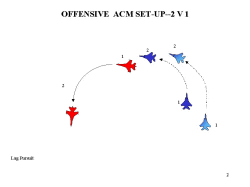 Lag Pursuit. Click any image for larger.
Notice that Eagle 1 is doing most of the talking. Why? He is the lead, saw the bandit first, and called "Engaged." Eagle 2's job is now to support #1 and help kill the bandit through maneuvering to an offensive position and/or watching to make sure no other bandit sneaks up and kills both of them (sneaky gomers wouldn't do that--would they?) At this point one of three options exists. #2 can turn with #1' #2 can extend and gain maneuvering room in order to enter the fight at a better advantage. #2 can cut across the turn circle and try and bracket the bandit. Each option has its own merits.
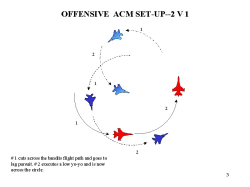 Lag Pursuit. Option One By turning with #1, #2 maintains good mutual support and tally on the bandit. As #1 continues to turn with the bandit, #2 can slide to the outside and try for a firing solution. However, it may take some time for this to develop. If the bandit reverses his turn, this helps out the firing solution and both #1 and #2 should be presented a shot. If the bandit continues, #1 should be able to achieve a shot or have #2 engage.
 Extension. Option Two #2 extends as #1 turns with the bandit. #2 uses the extension as a means to build separation and enter the fight from a favorable angle. Additionally, it is hoped the bandit will lose sight of #2 and #2 will have an un-observed entry on the bandit. The bandit is presented with a catch-22. Whichever way he turns, a fighter is in position to engage him. |
Option Three #2 cuts across the circle at the initial turn. This in effect puts the bandit in a mini-bracket and again whichever way he turns, a fighter is in position to engage him.
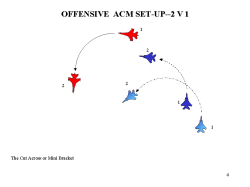 Mini Bracket. Again, comm is essential to the element. Let's continue with an example of typical comm while engaged.
Eagle 1 has given the command for Eagle 2 to extend North and work an entry from that direction.
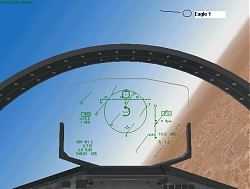 Janes F15 HUD Simple but effective comm and a bandit kill! TRNMSN5 should be practiced using different formations, different ranges to the bandit, and different maneuvering options until the training pilot is proficient. TRNMSN 6-1v2 Defensive ACM This mission is the reverse of MSN 5. Its purpose is to practice defensive maneuvers and communication against a cooperative attacker. In this scenario, the attacker is briefed in one of three options to use against the element. Option 1 is to stay on the initial target throughout the fight. Option 2 is to perform an early switch, to initially attack one target but quickly switch to the other fighter and then stick with that target. Option 3 is to perform a late switch. This option again involves initially targeting one fighter to get him to turn and then coming off that bandit and switching to the other fighter. The element can perform 1 of 3 defensive maneuvers to counter the initial attack. The key, however, is to first detect the attack and this is why the line abreast formation is the "best" choice for a formation. TRNMSN 6 begins with the same set-up parameters as TRNMSN 5 except the bandit is the attacker.
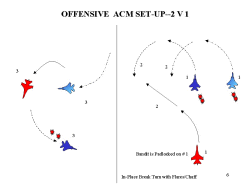 Bandit Padlocked on #1. Initial Defensive Moves Once the attack is detected (either through visual, RWR, or missile trail/gunshot) the element can perform one of three moves. The element can perform an in-place turn. This forces the attacker to choose one target (if he hasn't). This fighter becomes the defensive fighter and the other fighter can maneuver for a shot.
The free fighter is able to reverse the initial turn and gain offensive position on the bandit. Essentially, you have created a sandwich with the bandit sandwiched between #1 and #2. #1, however, is in a precarious position and #2 must act quickly. Go to Page Three
|
|||
|
© 1997 - 2000 COMBATSIM.COM, INC. All Rights Reserved. Last Updated March 18th, 1999 |
||||
